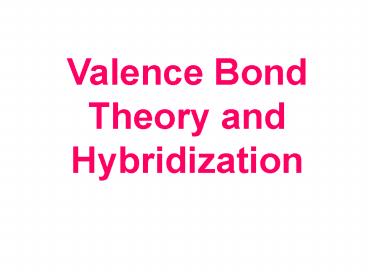Valence Bond Theory and Hybridization - PowerPoint PPT Presentation
1 / 31
Title:
Valence Bond Theory and Hybridization
Description:
Valence Bond Theory and Hybridization * Linus Pauling Author: Nature of the chemical bond Received Nobel prize in 1954 for his work Introduced concept of ... – PowerPoint PPT presentation
Number of Views:639
Avg rating:3.0/5.0
Title: Valence Bond Theory and Hybridization
1
Valence Bond Theory and Hybridization
2
- Linus Pauling
- Author Nature of the chemical bond
- Received Nobel prize in 1954 for his work
- Introduced concept of orbital hybridization
3
Valence bond theory the basic ideaTwo
half-filled orbitals overlap to form a covalent
bond. The electrons in this new probability
density are then shared by both atoms (equally
attracted to both nuclei). Arrange themselves to
have maximum overlap of their half filled
orbitals, producing a bonding orbital of lowest
energy!
4
Two s orbitals overlapping
5
all form covalent bonds- all overlapping
orbitals must be half-filled - the new
probability distribution formed can only have a
max of two electrons
Other overlaps
6
Types of covalent bonds
- Orbitals can overlap in two main ways creating
two different types of covalent bonds - Sigma bonds Pi bonds
7
The s bond
Electron density is between the nuclei of the
overlapping atoms
8
Single bondss bonds
9
The p bond
Electron densities are above and below the nuclei
of the bonding atoms
10
Only p orbitals can form pi bonds!
11
Double Bondone p bond one s bond
12
(No Transcript)
13
Triple bond two p bond one s bond
14
The benzene ring
15
(No Transcript)
16
Promotion Hybridization
- Certain atoms can change their electron
configuration in order to bond and form a wide
variety of compounds - This change in electron configuration takes
place in two steps Promotion of an electron to a
higher energy orbital hybridization or blending
of orbitals creating a new type of orbital for
bonding
17
Promotion
- Most of the time atoms exist in their ground
state but, in certain cases the instant before
bonding promotion takes place allowing more
bonding spaces
18
HybridizationThe merging of orbitals
- Merging orbitals must all be half filled
- No orbitals are lost due to merging if you
blend one s orbital and one p orbital you will
end up with TWO hybrid orbitals!
19
HybridizationContinued
- Mix at least 2 nonequivalent atomic orbitals (eg.
s and p). Hybrid orbitals have different shapes
from original atomic orbitals - Covalent bonds are formed by
- Overlap of hybrid orbitals with atomic orbitals
- Overlap of hybrid orbitals with other hybrid
orbitals
20
Example Hybridization in carbon to form methane
(CH4)
21
(No Transcript)
22
Types Names of hybrid orbitals
- The type of hybrid orbital depends upon the
orbitals which have been blended
23
sp2 Hybridization in BF3
- ?_ _ _
- ? ? 2p1 Unhybridized Boron
- 2s2
- For BF3, 3 hybrid orbitals are needed, so 3
atomic orbitals are required as follows (s p
p) sp2 - ?_ ?_ ?_
- sp2 sp2 sp2 Hybridized Boron
24
3 sp2 orbitals needed to form 3 sigma bonds
25
sp Hybridization in BeCl2
- _ _ _
- ? ? 2p Unhybridized Be
- 2s2
- For BeCl2, 2 hybrid orbitals are needed, so 2
atomic orbitals are required as follows (s p )
sp - ?_ ?_
- sp sp Hybridized Be
26
(No Transcript)
27
- Once hybridization has occurred hybridized
orbitals are ready to bond just like regular
orbitals - Bonding in hybridized orbitals
28
Because of their shape, hybrid orbitals can
only undergo sigma bonding.
29
Shapes Hybrids a little trick 0)
30
Hybridization Involving d Orbitals
3s 3p 3d
3s 3p
3d
unhybridized P atom P Ne3s23p3
vacant d orbitals
degenerate orbitals (all EQUAL)
Trigonal bipyramidal
31
Sigma and Pi Bonds
- Single Bond 1 sigma bond
- Double Bond 1 sigma bond and 1 pi bond
- Triple Bond 1 sigma bond and 2 pi bonds
















![Chapter 10: Chemical Bonding II: Molecular Shapes, Valence Bond Theory, and Molecular Orbital Theory 10.1 Artificial Sweeteners: Fooled by Molecular Shape (Suggested Reading) 10.2 VSEPR Theory: The Five Basic Shapes [10.1] 10.3 VSEPR Theory: The PowerPoint PPT Presentation](https://s3.amazonaws.com/images.powershow.com/4815694.th0.jpg?_=20131208022)














